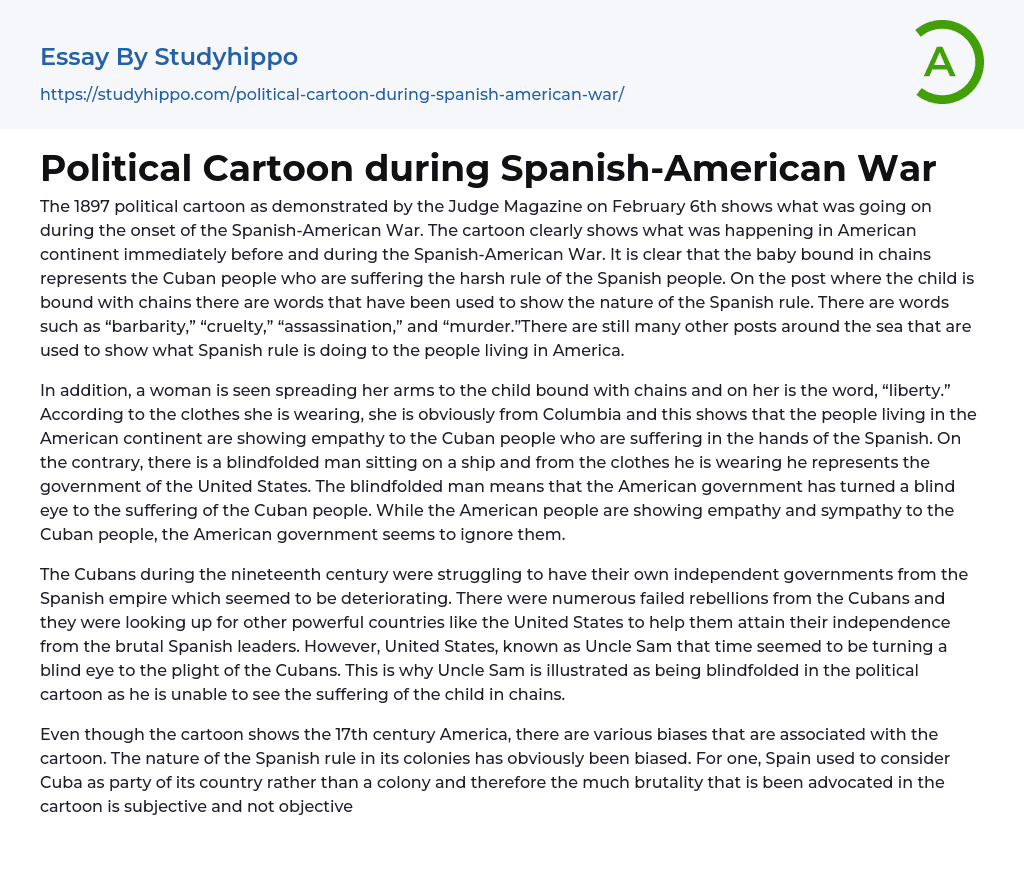

Political Cartoon during Spanish-American War Essay Example
The 1897 political cartoon as demonstrated by the Judge Magazine on February 6th shows what was going on during the onset of the Spanish-American War. The cartoon clearly shows what was happening in American continent immediately before and during the Spanish-American War. It is clear that the baby bound in chains represents the Cuban people who are suffering the harsh rule of the Spanish people. On the post where the child is bound with chains there are words that have been used to show the nature of the Spanish rule. There are words such as “barbarity,” “cruelty,” “assassination,” and “murder.”There are still many other posts around the sea that are used to show what Spanish rule is doing to the people living in America.
In addition, a woman is seen spreading her arms to the child bound with ch
...ains and on her is the word, “liberty.” According to the clothes she is wearing, she is obviously from Columbia and this shows that the people living in the American continent are showing empathy to the Cuban people who are suffering in the hands of the Spanish. On the contrary, there is a blindfolded man sitting on a ship and from the clothes he is wearing he represents the government of the United States. The blindfolded man means that the American government has turned a blind eye to the suffering of the Cuban people. While the American people are showing empathy and sympathy to the Cuban people, the American government seems to ignore them.
The Cubans during the nineteenth century were struggling to have their own independent governments from the Spanish empire which seemed to be deteriorating. There wer
numerous failed rebellions from the Cubans and they were looking up for other powerful countries like the United States to help them attain their independence from the brutal Spanish leaders. However, United States, known as Uncle Sam that time seemed to be turning a blind eye to the plight of the Cubans. This is why Uncle Sam is illustrated as being blindfolded in the political cartoon as he is unable to see the suffering of the child in chains.
Even though the cartoon shows the 17th century America, there are various biases that are associated with the cartoon. The nature of the Spanish rule in its colonies has obviously been biased. For one, Spain used to consider Cuba as party of its country rather than a colony and therefore the much brutality that is been advocated in the cartoon is subjective and not objective. There are a lot of words that has been used to describe the nature of the Spanish rule in its American colonies. The Judge Magazine cartoon is a kind of tool used to spread propaganda about the “atrocities” committed by the Spanish rule against its American colonies. The political cartoon is used to paint the Spanish people as brutally evil and this is the imagery that they used to spread propaganda throughout the American continent. The cartoon shows that the Spanish people are imposing their rule in the Cubans through shedding blood of the citizens.
The political cartoon image also shows the facts before the beginning of the Spanish-American War. The Cuban people were suffering because they were trying to fight for the independence of their own country and the Spanish people were
not letting them do that. They wanted Cuba to be a part of the Spanish nation. However, the extreme brutality advocated in the image is propaganda to drive people to the brink of the war between America and Spain. Maybe the illustrations on the cartoon were intended for people to be against the Spanish people and to support America in their war against the Spanish because they had some interests in some of the Spanish colonies like Cuba.
Reference
- Tucker, Spencer. The Encyclopedia of the Spanish-American and Philippine-American Wars: A Political, Social, and Military History. Santa Barbara, Calif: ABC-CLIO, 2009.
- Manning, Martin J., and Clarence R. Wyatt. Encyclopedia of Media and Propaganda in Wartime America. Santa Barbara, Calif: ABC-CLIO, 2011.
- Davis, Robert Nathan. Race and Political Cartoons During the Spanish-American War and Filipino Insurrection: Ideology and the American Consciousness, 1898-1902. Lexington, Ky: publisher not identified, 2007.
- Lammoglia, Jose A. The Spanish American War Through the Eyes of a Political Cartoonist. 1999.
- Spencer,Tucker. The Encyclopedia of the Spanish-American and Philippine-American Wars: A Political, Social, and Military History. Santa Barbara, Calif: ABC-CLIO, 2009. p. 504
- Martin,Manning J., and Wyatt,Clarence R. Encyclopedia of Media and Propaganda in Wartime America. Santa Barbara, Calif: ABC-CLIO, 2011. p. 393
- Nathan,Davis. Race and Political Cartoons During the Spanish-American War and Filipino Insurrection: Ideology and the American Consciousness, 1898-1902. Lexington, Ky: publisher not identified, 2007.
- Jose Lammoglia A. The Spanish American War Through the Eyes of a Political Cartoonist. 1999.
- Magazine essays
- Newspaper essays
- Absolutism essays
- Appeal essays
- Bourgeoisie essays
- Contras essays
- Corporate Governance essays
- Corruption essays
- Democracy essays
- Democratic Party essays
- Developed Country essays
- Dictatorship essays
- Elections essays
- European Union essays
- Federalism essays
- Foreign essays
- Foreign policy essays
- Gentrification essays
- Hillary Clinton essays
- Income Tax essays
- International Relations essays
- John Marshall essays
- John Stuart Mill essays
- Left-Wing Politics essays
- Liberty essays
- Military essays
- Monarch essays
- Monarchy essays
- Political Corruption essays
- Political Party essays
- Political Science essays
- President Of The United States essays
- Public Service essays
- Red Cross essays
- Reform essays
- Republic essays
- Revenge essays
- Social Security essays
- Sovereign State essays
- State essays
- Supply essays
- Terrorism essays
- United Nations essays
- World Trade Organization essays
- American Civil War essays
- Atomic Bomb essays
- Attack essays
- Cold War essays
- Crimean War essays
- Diplomacy essays



